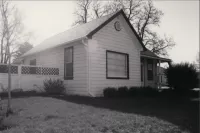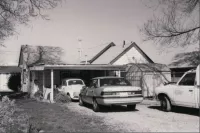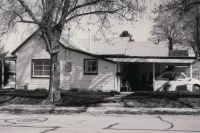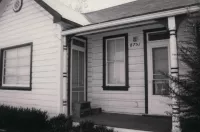Share what you know,
and discover more.
Share what you know,
and discover more.
Dec 09, 1999

-

- Charmaine Bantugan
National Register of Historic Places - Orlando H. and Emma H. Hardcastle House
Statement of Significant: The Orlando H. and Emma H. Hardcastle House, built c. 1893, is significant under Criterion A for its association with the Mining, Smelting, and Small Farm Era, 1871-c. 1910 of Sandy City. The Hardcastle’s were early residents of Sandy. Orlando Hardcastle was employed as a foreman for many years at the Mingo smelter in Sandy. He later transferred to the smelter In Murray. The house also represents the Specialized Agriculture, Small Business, and Community Development Period (1906- 1946), the second period of development in Sandy. The Hardcastle house is an example of a common house type, the cross wing, built by residents of Sandy during this era. It is in excellent condition and despite some modifications from the 1950s, it retains many of its Victorian Eclectic details. The Hardcastle House is being nominated as part of the multiple property nomination, Historic Resources of Sandy City. Historical Significance Located 12 miles south of Salt Lake City, historic Sandy is at the crossroads of what was once a busy series of mining districts. Paralleling to a large extent the history of mining in Bingham Canyon to the west and Big and Little Cottonwood Canyons to the east, Sandy's history and development either boomed or declined based on these mining operations. Sandy's first major period of development is known as the Mining, Smelting, and Small Farm Era, 1871-c. 1910 During this period Sandy became a strategic shipping point and a number of sampling mills and smelters were built in the area. While the dominant force in the economy of Sandy during the 1870s through the 1890s was undoubtedly that of mining, the local agricultural community continued to develop. The majority of those involved in agriculture were members of the Church of Jesus Christ of Latter-day Saints (LDS or Mormon Church) who were encouraged to pursue agriculture instead of mining. Orlando Hardcastle, who worked for more three decades as a smelter foreman, represents those early residents of Sandy involved in smelting and refining industries. The Specialized Agriculture, Small Business, and Community Development Period (1906-1946) is the second period of development in Sandy. It encompasses the first half of the twentieth century and was a period of transition for the city. The mining, smelting and small farm era (1871-circa 1910) was being replaced by a more diversified economy. In some ways the town still resembled the earlier predominantly agricultural community founded by Mormon settlers in the 1860s, especially as the "boom town" economy created around the mining industry waned. The population of Sandy remained around 1,500 for the four decades between 1900 and 1940.'' However, the city was defining itself as the political, economic, civic and social center for a major portion of the southeast Salt Lake Valley. This period of Sandy's history laid the groundwork for city's eventual transformation from small town to suburb. One of the earliest signs of community development was the creation of subdivisions from large farming parcels. During the first half of the twentieth century, the majority of Sandy residents continued to live on their farms, however most managed to survive economically by combining subsistence farming with other occupations, primarily cottage industries and mercantilism. Other - farmers created large specialized agricultural enterprises such as sugar beets and poultry. Many Sandy residents continued to work in the mining and smelter industries in nearby communities after the smelters closed down. The history of the Hardcastle family spans these two periods of Sandy's development. The property at 8751 South 40 East was originally owned by LeGrand and Grace Young. The Youngs owned large tracts of land in Sandy in the late-nineteenth century. Orlando Hardcastle purchased the property on December 9, 1893 for $70.00. The house was most likely built soon after that date. Orlando Heathcote Hardcastle was born on February 26, 1863, in Sheffield, England, to William and Rosebelle Fletcher Hardcastle. The family immigrated to Utah when Orlando was around thirteen years-old. Emma Hardcastle was born in West Jordan, Utah, on October 31, 1864. Her parents were John and Treenie Dungore Hardcastle. Orlando and Emma were married on February 19, 1882, and probably settled in Sandy (where Emma's father owned a saloon) immediately after their marriage. Starting in 1882, fourteen children were born to them In Sandy. Orlando and Emma's family consisted of eight daughters and six sons, eleven of which grew to maturity. Several of the Hardcastle children remained in Sandy to raise their families. Orlando Hardcastle worked as a foreman and shift boss at the Mingo smelter in Sandy until it closed in 1901. He then worked as a foreman at the American Smelting and Refining plant in Murray. He was an active member of the I.O.O.F. for thirty-five years, holding various offices in that organization. Orlando Hardcastle died on February 7, 1932. Emma Hardcastle died on June 19, 1940, leaving a posterity of thirty-eight grandchildren and thirty-four great-grandchildren. Two years after Emma's death, the house and property were deeded to one of her daughters, Loretta Hardcastle Ellswood. Loretta and her husband John lived in the house for many years. It remained in the family until 1994 when it was sold to James Witherspoon. The house is currently being used as a rental property.
National Register of Historic Places - Orlando H. and Emma H. Hardcastle House
Statement of Significant: The Orlando H. and Emma H. Hardcastle House, built c. 1893, is significant under Criterion A for its association with the Mining, Smelting, and Small Farm Era, 1871-c. 1910 of Sandy City. The Hardcastle’s were early residents of Sandy. Orlando Hardcastle was employed as a foreman for many years at the Mingo smelter in Sandy. He later transferred to the smelter In Murray. The house also represents the Specialized Agriculture, Small Business, and Community Development Period (1906- 1946), the second period of development in Sandy. The Hardcastle house is an example of a common house type, the cross wing, built by residents of Sandy during this era. It is in excellent condition and despite some modifications from the 1950s, it retains many of its Victorian Eclectic details. The Hardcastle House is being nominated as part of the multiple property nomination, Historic Resources of Sandy City. Historical Significance Located 12 miles south of Salt Lake City, historic Sandy is at the crossroads of what was once a busy series of mining districts. Paralleling to a large extent the history of mining in Bingham Canyon to the west and Big and Little Cottonwood Canyons to the east, Sandy's history and development either boomed or declined based on these mining operations. Sandy's first major period of development is known as the Mining, Smelting, and Small Farm Era, 1871-c. 1910 During this period Sandy became a strategic shipping point and a number of sampling mills and smelters were built in the area. While the dominant force in the economy of Sandy during the 1870s through the 1890s was undoubtedly that of mining, the local agricultural community continued to develop. The majority of those involved in agriculture were members of the Church of Jesus Christ of Latter-day Saints (LDS or Mormon Church) who were encouraged to pursue agriculture instead of mining. Orlando Hardcastle, who worked for more three decades as a smelter foreman, represents those early residents of Sandy involved in smelting and refining industries. The Specialized Agriculture, Small Business, and Community Development Period (1906-1946) is the second period of development in Sandy. It encompasses the first half of the twentieth century and was a period of transition for the city. The mining, smelting and small farm era (1871-circa 1910) was being replaced by a more diversified economy. In some ways the town still resembled the earlier predominantly agricultural community founded by Mormon settlers in the 1860s, especially as the "boom town" economy created around the mining industry waned. The population of Sandy remained around 1,500 for the four decades between 1900 and 1940.'' However, the city was defining itself as the political, economic, civic and social center for a major portion of the southeast Salt Lake Valley. This period of Sandy's history laid the groundwork for city's eventual transformation from small town to suburb. One of the earliest signs of community development was the creation of subdivisions from large farming parcels. During the first half of the twentieth century, the majority of Sandy residents continued to live on their farms, however most managed to survive economically by combining subsistence farming with other occupations, primarily cottage industries and mercantilism. Other - farmers created large specialized agricultural enterprises such as sugar beets and poultry. Many Sandy residents continued to work in the mining and smelter industries in nearby communities after the smelters closed down. The history of the Hardcastle family spans these two periods of Sandy's development. The property at 8751 South 40 East was originally owned by LeGrand and Grace Young. The Youngs owned large tracts of land in Sandy in the late-nineteenth century. Orlando Hardcastle purchased the property on December 9, 1893 for $70.00. The house was most likely built soon after that date. Orlando Heathcote Hardcastle was born on February 26, 1863, in Sheffield, England, to William and Rosebelle Fletcher Hardcastle. The family immigrated to Utah when Orlando was around thirteen years-old. Emma Hardcastle was born in West Jordan, Utah, on October 31, 1864. Her parents were John and Treenie Dungore Hardcastle. Orlando and Emma were married on February 19, 1882, and probably settled in Sandy (where Emma's father owned a saloon) immediately after their marriage. Starting in 1882, fourteen children were born to them In Sandy. Orlando and Emma's family consisted of eight daughters and six sons, eleven of which grew to maturity. Several of the Hardcastle children remained in Sandy to raise their families. Orlando Hardcastle worked as a foreman and shift boss at the Mingo smelter in Sandy until it closed in 1901. He then worked as a foreman at the American Smelting and Refining plant in Murray. He was an active member of the I.O.O.F. for thirty-five years, holding various offices in that organization. Orlando Hardcastle died on February 7, 1932. Emma Hardcastle died on June 19, 1940, leaving a posterity of thirty-eight grandchildren and thirty-four great-grandchildren. Two years after Emma's death, the house and property were deeded to one of her daughters, Loretta Hardcastle Ellswood. Loretta and her husband John lived in the house for many years. It remained in the family until 1994 when it was sold to James Witherspoon. The house is currently being used as a rental property.
Dec 09, 1999
National Register of Historic Places - Orlando H. and Emma H. Hardcastle House
Statement of Significant:The Orlando H. and Emma H. Hardcastle House, built c. 1893, is significant under Criterion A for its association with the Mining, Smelting, and Small Farm Era, 1871-c. 1910 of Sandy City. The Hardcastle’s were early residents of Sandy. Orlando Hardcastle was employed as a foreman for many years at the Mingo smelter in Sandy. He later transferred to the smelter In Murray. The house also represents the Specialized Agriculture, Small Business, and Community Development Period (1906- 1946), the second period of development in Sandy. The Hardcastle house is an example of a common house type, the cross wing, built by residents of Sandy during this era. It is in excellent condition and despite some modifications from the 1950s, it retains many of its Victorian Eclectic details. The Hardcastle House is being nominated as part of the multiple property nomination, Historic Resources of Sandy City.
Historical Significance
Located 12 miles south of Salt Lake City, historic Sandy is at the crossroads of what was once a busy series of mining districts. Paralleling to a large extent the history of mining in Bingham Canyon to the west and Big and Little Cottonwood Canyons to the east, Sandy's history and development either boomed or declined based on these mining operations. Sandy's first major period of development is known as the Mining, Smelting, and Small Farm Era, 1871-c. 1910 During this period Sandy became a strategic shipping point and a number of sampling mills and smelters were built in the area. While the dominant force in the economy of Sandy during the 1870s through the 1890s was undoubtedly that of mining, the local agricultural community continued to develop. The majority of those involved in agriculture were members of the Church of Jesus Christ of Latter-day Saints (LDS or Mormon Church) who were encouraged to pursue agriculture instead of mining. Orlando Hardcastle, who worked for more three decades as a smelter foreman, represents those early residents of Sandy involved in smelting and refining industries.
The Specialized Agriculture, Small Business, and Community Development Period (1906-1946) is the second period of development in Sandy. It encompasses the first half of the twentieth century and was a period of transition for the city. The mining, smelting and small farm era (1871-circa 1910) was being replaced by a more diversified economy. In some ways the town still resembled the earlier predominantly agricultural community founded by Mormon settlers in the 1860s, especially as the "boom town" economy created around the mining industry waned. The population of Sandy remained around 1,500 for the four decades between 1900 and 1940.'' However, the city was defining itself as the political, economic, civic and social center for a major portion of the southeast Salt Lake Valley.
This period of Sandy's history laid the groundwork for city's eventual transformation from small town to suburb. One of the earliest signs of community development was the creation of subdivisions from large farming parcels. During the first half of the twentieth century, the majority of Sandy residents continued to live on their farms, however most managed to survive economically by combining subsistence farming with other occupations, primarily cottage industries and mercantilism. Other - farmers created large specialized agricultural enterprises such as sugar beets and poultry. Many Sandy residents continued to work in the mining and smelter industries in nearby communities after the smelters closed down. The history of the Hardcastle family spans these two periods of Sandy's development.
The property at 8751 South 40 East was originally owned by LeGrand and Grace Young. The Youngs owned large tracts of land in Sandy in the late-nineteenth century. Orlando Hardcastle purchased the property on December 9, 1893 for $70.00. The house was most likely built soon after that date. Orlando Heathcote Hardcastle was born on February 26, 1863, in Sheffield, England, to William and Rosebelle Fletcher Hardcastle. The family immigrated to Utah when Orlando was around thirteen years-old. Emma Hardcastle was born in West Jordan, Utah, on October 31, 1864. Her parents were John and Treenie Dungore Hardcastle. Orlando and Emma were married on February 19, 1882, and probably settled in Sandy (where Emma's father owned a saloon) immediately after their marriage. Starting in 1882, fourteen children were born to them In Sandy. Orlando and Emma's family consisted of eight daughters and six sons, eleven of which grew to maturity. Several of the Hardcastle children remained in Sandy to raise their families.
Orlando Hardcastle worked as a foreman and shift boss at the Mingo smelter in Sandy until it closed in 1901. He then worked as a foreman at the American Smelting and Refining plant in Murray. He was an active member of the I.O.O.F. for thirty-five years, holding various offices in that organization. Orlando Hardcastle died on February 7, 1932. Emma Hardcastle died on June 19, 1940, leaving a posterity of thirty-eight grandchildren and thirty-four great-grandchildren. Two years after Emma's death, the house and property were deeded to one of her daughters, Loretta Hardcastle Ellswood. Loretta and her husband John lived in the house for many years. It remained in the family until 1994 when it was sold to James Witherspoon. The house is currently being used as a rental property.
Posted Date
Jun 26, 2023
Historical Record Date
Dec 09, 1999
Source Name
National Register of Historic Places
Source Website
Delete Story
Are you sure you want to delete this story?













